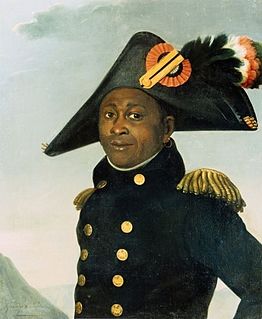
François-Dominique Toussaint Louverture was a Haitian general and the most prominent leader of the Haitian Revolution. During his life, Louverture first fought against the French, then for them, and then finally against France again for the cause of Haitian independence. As a revolutionary leader, Louverture displayed military and political acumen that helped transform the fledgling slave rebellion into a revolutionary movement. Louverture is now known as the "Father of Haiti".

Jean-Jacques Dessalines was a leader of the Haitian Revolution and the first ruler of an independent Haiti under the 1805 constitution. Under Dessalines, Haiti became the first country to permanently abolish slavery. Initially regarded as governor-general, Dessalines was later named Emperor of Haiti as Jacques I (1804–1806) by generals of the Haitian Revolution Army and ruled in that capacity until being assassinated in 1806. He is the father of the nation Haiti.

The Haitian Revolution was a successful insurrection by self-liberated slaves against French colonial rule in Saint-Domingue, now the sovereign state of Haiti. The revolt began on 22 August 1791, and ended in 1804 with the former colony's independence. It involved black, biracial, French, Spanish, British, and Polish participants—with the ex-slave Toussaint Louverture emerging as Haiti's most charismatic hero. The revolution was the only slave uprising that led to the founding of a state which was both free from slavery and ruled by non-whites and former captives. It is now widely seen as a defining moment in the history of the Atlantic World.

Prince Jean-Louis Michel Pierrot, Baron of Haïti was a career officer general in the Haitian Army who also served as President of Haiti from 16 April 1845 to 1 March 1846.
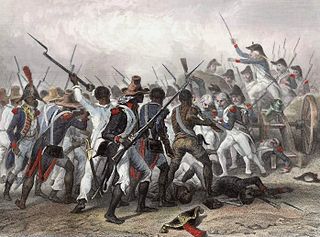
The Battle of Crête-à-Pierrot was a major battle of the Haitian Revolution that took place from 4 March until 24 March 1802.

The Battle of Ravine-à-Couleuvres, also known as the Battle of Snake Gully, was a major battle of the Haitian Revolution on 23 February 1802.

The Black Jacobins: Toussaint L'Ouverture and the San Domingo Revolution is a 1938 book by Trinidadian historian C. L. R. James, a history of the Haitian Revolution of 1791–1804. He went to Paris to research this work, where he met Haitian military historian Alfred Auguste Nemours. James's text places the revolution in the context of the French Revolution, and focuses on the leadership of Toussaint L'Ouverture, who was born a slave but rose to prominence espousing the French Revolutionary ideals of liberty and equality. These ideals, which many French revolutionaries did not maintain consistently with regard to the black humanity of their colonial possessions, were embraced, according to James, with a greater purity by the persecuted blacks of Haiti; such ideals "meant far more to them than to any Frenchman."
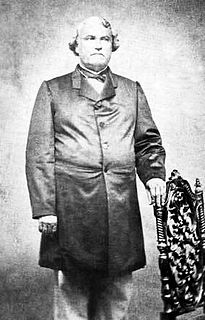
Thomas Madiou was a Haitian historian. His work Histoire d'Haïti is the first complete history of Haiti from 1492 to 1846. It is considered one of the most valuable documents of Haitian history and literature.
Joseph Saint-Rémy (1818–1856) was a Haitian historian. He is best known for his biography La Vie de Toussaint Louverture about the Haitian Revolution leader Toussaint L'Ouverture, and for his work Pétion et Haïti, about another Revolutionary figure, Alexandre Pétion. Born in Guadeloupe, Saint-Rémy emigrated to Haiti as a young child and grew up in Les Cayes before leaving for school in France.
The War of Knives, also known as the War of the South, was a civil war from June 1799 to July 1800 between the Haitian revolutionary Toussaint Louverture, a black ex-slave who controlled the north of Saint-Domingue, and his adversary André Rigaud, a mixed-race free person of color who controlled the south. Louverture and Rigaud fought over de facto control of the French colony of Saint-Domingue during the war. Their conflict followed the withdrawal of British forces from the colony during the early stages of the Haitian Revolution. The war resulted in Toussaint taking control of the entirety of Saint-Domingue, and Rigaud fleeing into exile.
Lamour Desrances was a Haitian revolutionary leader. A former maroon, he was born in Africa and brought to Saint-Domingue as a slave. During the revolution, when local figures often gained power in control of small armed forces, Desrances became a local military leader in the mountains surrounding Port-au-Prince and Saint-Marc.
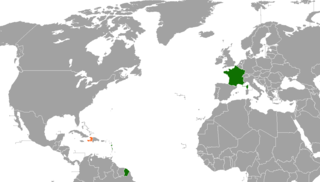
France–Haiti relations are foreign relations between France and Haiti. Both nations are members of the Organisation internationale de la Francophonie, United Nations, and the World Trade Organization.
The siege of Port-au-Prince took place during the Haitian Revolution.
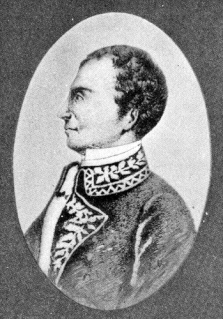
The Battle of Croix-des-Bouquets took place during the Haitian Revolution.
The Battle of Saint-Raphaël took place during the Haitian Revolution.
The Battle of Gonaïves took place during the Haitian Revolution.

The Battle of Cap-Français took place from 20 to 22 June 1793 during the Haitian Revolution.
Étienne Maynaud de Bizefranc de Laveaux was a French general who was Governor of Saint-Domingue from 1793 to 1796 during the French Revolution. He ensured that the law that freed the slaves was enforced, and supported the black leader Toussaint Louverture, who later established the independent republic of Haiti. After the Bourbon Restoration he was Deputy for Saône-et-Loire from 1820 to 1823.
Toussaint Louverture - The Story of the Only Successful Slave Revolt in History is a three-act play about Toussaint L'Ouverture, the leader of the Haitian Revolution, written by C. L. R. James in 1934. In March 1936, the play was staged for two performances in the Westminster Theatre in London's West End by the Stage Society, a private club, to avoid Theatres Act censorship laws. It was directed by Peter Godfrey and starred Paul Robeson in the title role, as well as Orlando Martins as Dutty Boukman, Robert Adams as Jean-Jacques Dessalines and Harry Andrews. It was the first time black professional actors featured in a production written by a black playwright in the UK. The play had been presumed lost until its rediscovery of a draft copy in 2005 by historian Christian Høgsbjerg. The play was published for the first time in 2013 by Duke University Press, with a foreword by Laurent Dubois and an introduction by Christian Høgsbjerg. Toussaint Louverture is perhaps the last major piece of James's work to be published.
In 1789 is made the Declaration of the Rights of Man and of the Citizen, set by France's National Constituent Assembly. In 1791, the enslaved Africans of Saint-Domingue began the Haitian Revolution, aimed at the overthrow of the colonial regime.










